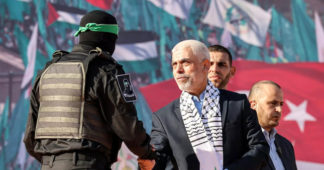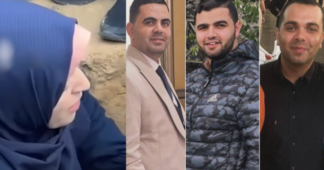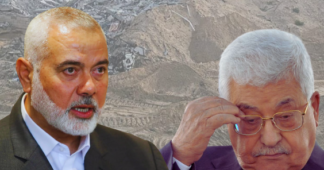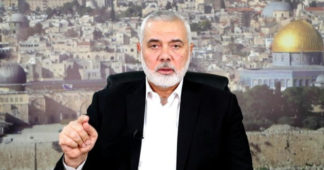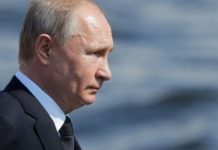The concepts of self-sacrifice, asceticism, and security awareness were crucial to Yahya Sinwar’s philosophy of resistance. The revolt that culminated with October 7 was the direct application of his political thought.
The following was originally published in Arabic in Babelwad, titled “The Philosophy of Hamas: Politics and Existence According to Yahya Sinwar,” by Haneen Odetallah. The author uses Hamas leader Yahya Sinwar’s novel, “Thorns and Carnations,” as a lens through which the mindset of the contemporary resistance can be analyzed, delving into themes of self-reliance, sacrifice, and security awareness. Odetallah explores how these concepts are ingrained in individuals to foster political ascendancy and collective liberation, illustrating the strategic and existential dimensions of resistance and providing a unique perspective on the ideological framework of the resistance.
“We must enter Sinwar’s mind” is the slogan of the current phase in the “Israeli” media, which continues to broadcast loud condemnations after Yahya Sinwar, the head of the Islamic Resistance Movement (Hamas) in Gaza, carried out the greatest military-intelligence deception in their entity’s history. Sinwar surprised them in a battle named “Al-Aqsa Flood,” but its real headline is that of Palestinian prisoners, to whom Sinwar has remained loyal — being a former prisoner himself who was liberated in a prisoner swap called the “Loyalty of the Free” deal.
Sinwar spent 23 years of his life in prison, including four years in solitary confinement, but he did not waste any of those years. He learned Hebrew and everything he could about his enemy, even formulating and executing a long-term intelligence plan from behind bars, which at the time was far-reaching. Sinwar studied and thought extensively, and he also wrote. Although we need not “enter Sinwar’s mind,” I believe that we, too, should at least “get to know his thinking,” to use a less intrusive expression.
But what might be easier than “entering Sinwar’s mind” is to read the writings he undertook after years of isolation, contemplation, and study.
In 2004, after a complex and protracted operation that required great effort and the recruitment of many prisoners, Yahya Sinwar, then a prisoner, published his novel, Thorns and Carnations, or “Thorns of Carnations,” as the writer intended. The novel deals with a thread from the story of the Palestinian struggle in the historical era between 1967 and the Al-Aqsa Intifada of the early 2000s, and the emergence of the Islamic movement in the Palestinian resistance — specifically the Islamic Resistance Movement, or Hamas — against its social, political, and cultural background.
The novel tells a story that begins in a house in a refugee camp in Gaza that will shape the values and choices of these children, who will grow up to become active and key figures in the Islamic Resistance Movement. The story then expands to include relatives, neighbors, the people of the camp, the Gaza Strip, the West Bank, and the rest of the occupied lands, where each character forms a stone that builds the experience of the Islamic Resistance Movement in those years.
The historical novel as a vessel for philosophy
This novel features fictional characters, but all its events are real; the fictional aspect arises from transforming these events into a work that meets the conditions of a novel, as the writer notes in the introduction. The choice of the writer, primarily a political and military figure, to document this pivotal stage in the history of armed resistance and transmit it in this creative, novelistic form indicates that it is an attempt that goes beyond merely recounting history and its events. The historical novel is not just a reflection of the events of the past; it is a deep exploration of the philosophical and moral forces that shape historical movements. The characters in historical novels embody and engage in philosophical struggles within the context of their time.[1] In other words, it serves as a means to understand the complex relationship between personal beliefs and the broader expanse of history. As for the writer, he is one of the pioneering figures in Hamas who witnessed its inception and contributed to its formation and development from youth to the present day. His departure from the confines of traditional historiography to address innovative dramatic struggles in history allows him to explore its philosophical dimensions; specifically, the impact of beliefs on history. In the context of the history of Hamas, this enables him to formulate a philosophy for the Islamic Resistance Movement.
The story is told through the perspective of Ahmad, the son of the refugee camp who first opens his eyes to the world’s harshness: the camp, the war, and the disappearance of his father, a resistance fighter, without a trace. Ahmad observes the camp environment and living conditions, witnessing the poverty, the cold, and the rain that seeps through the ceiling as they sleep and follows them to their classroom in the UNRWA school. He observes the camp’s community and its culture, seeing his mother’s concern for other people’s honor and reputation — especially when it involves their daughters — and her strictness in this matter. Conversely, he experiences joy in accompanying his grandfather to prayer and social gatherings in the camp mosque.
Ahmad observes the political transformations in the camp, in the Gaza Strip, in the West Bank, and throughout the occupied lands; he witnesses curfews, sieges, the relentless hunt for resistance fighters, and collective punishment. He witnesses the normalization of occupation, material stability, work permits, and recreational trips into the occupied lands, through which more individuals are compelled and coerced into collaboration with the enemy. Ahmad observes the “israeli” prisons from which he, his brothers, relatives, and acquaintances emerged, witnessing the power of determination and organization in changing reality. Most importantly, Ahmad watches how the weapons and the struggle for freedom evolve in response to these conditions, seeing men who were shaped by the resistance and who, in turn, shaped it. Ahmad traces the emergence of Hamas by following the characters who formed, developed, and embodied it, summarized in his cousin Ibrahim, the martyr’s son who grew up with him in the same house with the same mother, and who grew to become a model of true leadership and political destiny-making.
The narrator plays the role of an involved observer; he doesn’t just watch, but he accompanies Ibrahim in his work, his education, and his journey of struggle. Despite joining Ibrahim in demonstrations, organizing religious and educational sit-ins in Al-Aqsa mosque, and security work in chasing collaborators, the narrator denies joining the Movement officially until the end: “Although I did not consider myself an ‘Islamic Bloc’ member or a supporter, I had no choice but to elect my cousin and his list, as our shared life and my personal admiration for him did not allow me to do otherwise.”
This intellectual distance that the narrator maintains suggests something; he indicates his detachment from the Movement by denying his affiliation, yet he simultaneously indicates his proximity to Ibrahim, one of the Movement’s prominent figures and founders. The narrator views Ibrahim and everything he represents with admiration, often describing him with transcendence and greatness; this gap between Ibrahim and the movement he represents makes Ibrahim a figure whose greatness surpasses that of the movement. Although Ibrahim does not directly clash with occupation forces and only becomes a martyr at the end of the book, he knows his fate from the beginning and pursues it, undeterred even by his attachment to his wife and children. Perhaps Ibrahim symbolizes a state of being that the narrator aspires for this political Movement to cultivate in society, or the model of the Palestinian individual that the writer hopes Hamas will create — achieving its goals of shaping self-determination and establishing a political entity for the Palestinians.
The self-made individual
Ibrahim’s transcendence, as perceived by the narrator, is linked to the concept of being “self-made,” which appears in two instances. In the first instance, the narrator notes that Ibrahim’s self-made nature has granted him a form of sovereignty over himself and a sense of purpose. “He even became a professional builder; he learned the trade from his friend, and they became partners, employing a worker to assist them, taking on medium-sized building contracts. It became clear that Ibrahim’s self-made nature was making a man out of him.”
Linguistically, the concept of being self-made refers to someone who has “achieved eminence by the virtue of their own character, not by the virtue of their ancestors” [2]. The term has been commonly used to describe anyone “toiling, striving to develop themselves through their own efforts” [3]. Thus, to be self-made can be considered philosophically as an existential practice where an individual finds the meaning of their existence and life by adhering to firm principles such as personal responsibility, autonomy, and intellectual freedom. These principles will elevate and develop the individual in pursuit of self-sovereignty and the shaping of their desired destiny.
In the second instance, the self-made individual is associated with the true leader; thus, being self-made is the foundation for a political leader capable of confronting the circumstances of occupation. “Every day, Ibrahim grew more transcendent and respected in my eyes; he was the one who grew up an orphan after his father was martyred when he was four years old, then was abandoned by his mother while still young, raised among us, and became a self-made man, and a true leader despite his young age and the difficult circumstances under occupation.”
When Ibrahim’s self-made nature merges with its political dimension, it makes him a leader; someone capable of developing not only himself but also his community and his people, elevating their collective condition. He carries them beyond, to overcome the difficult political circumstances towards freedom. For the narrator, Ibrahim embodies this model of the transcendent human being, who ascends and elevates themselves by finding the meaning of their existence in their commitment to the political role of uplifting their people. In other words, they ascend through a political practice philosophically founded on self-made principles.
The Übermensch and the self-made individual
In existential philosophy, Nietzsche introduces the idea of the “Übermensch” [4], an individual who has transcended and ascended to achieve true freedom embodied in the ability to shape their own destiny. According to Nietzsche, the transcendent individual is one who chooses their goals and selects their values, and principles without succumbing to any societal pressures beyond their control. This concept invites individuals to embrace what he calls the “Will to Power,” [5] an inner drive for liberation and self-sovereignty. Thus, the Übermensch forms an intellectual model of a person who overcomes societal values and standards that hinder them and creates their own values.
In contrast, Sinwar’s transcendent individual is the politically self-made individual; one who chooses their goals in a way that contributes to their political liberation. Therefore, they engage in shaping their identity and defining their values within the social and political fabric that shelters them. This process is not merely a personal quest for freedom but a political act that involves challenging and contributing to the formation of collective identity in a way that serves the freedom of the entire community.
The politically transcendent individual, through the self-made philosophy, is a model of the practical person who deals with inherited societal values—social, moral, and religious—as resources to enhance their community’s drive for liberation and to achieve political ascendance. They understand that their struggle against occupation is an existential battle and a war on the Palestinian “will to power”; that is, a war on their drive to politically self-govern. In this context, self-made philosophy transcends individual self-determination and becomes a tool to influence and shape political discourse. The hard-working individual committed to achieving their liberatory goal will harness all the efforts of others for that purpose as much as they can. As for the Islamic Resistance Movement, it seeks through Islamic values to produce this transcendent individual, or this state of being in the Palestinian individual; so how do these values contribute to that?
“The house became filled with men and women, boys and girls from the same family, and memories flooded back of us as children gathered in a small room that was too big for us. Our modest family had grown into a small army over the years… I mentioned this jokingly; my mother quickly shouted, ‘Send blessings upon the Prophet,’ a gentle reminder to mind my words. Immediately, everyone chorused, ‘O Allah, bless our master Muhammad.’”
Islam and the self-made individual
The novel begins in the winter of 1967, just before the Naksa, when Gaza was under the administration of Egypt. Ahmad, then five years old, recounts one of his earliest memories — his interactions with Egyptian soldiers whom he frequently visits. They would play with him and give him and his friends pistachio sweets. Then the war breaks out, and the soldiers shout at them to go back, and they no longer get any sweets.
“The occupation forces had faced fierce resistance in one area and withdrew. Shortly after, a group of tanks and military jeeps appeared, flying Egyptian flags. The resistance fighters rejoiced, thinking help had arrived, and they emerged from their positions and trenches, firing into the air in celebration. They gathered to welcome the reinforcements, but when the convoy approached, heavy fire was opened on the fighters, killing them. Then the zionist flag was raised on those tanks and vehicles, instead of the Egyptian flags.”
This scene signals an ideological turning point in the Palestinian struggle: the realization of the failure of Arab nationalism, or its inadequacy as a political current in inducing the necessary seriousness in individuals towards the Palestinian national cause, especially in the face of the ever-increasing voracity of the occupation.
While the philosophy of the self-made individual encompasses a condition for elevation, which is seriousness and commitment to the pursuit, “self-made individuals look at their goals with respect and belief, and they take the matter of achieving them with utmost seriousness, without compromise. They are simply committed to what they must do to achieve that” [6]. Here, the “extraordinary connection between religion and nationalism” achieves this seriousness through the obligation of jihad, or holy war, imbuing the national cause with sanctity and thus planting in the individual the strict seriousness necessary to achieve it, as the narrator states: “So that the battle takes its true dimension and meets the required standard.”
When the politically self-made individual looks around, they find the Islamic system among the last social systems that have remained steadfast among Palestinians in the face of societal annihilation, or sociocide, committed by the occupation. They find, in the intertwinement of political practice and faith, in transferring the reference of the Palestinian’s existence and purpose to Allah, a principle that the enemy cannot disintegrate. The self-made individual finds in historical Islamic sites, stable political edifices against occupation’s attempts to erode awareness and distort direction. Therefore, we find Ibrahim, who calls the battle “a battle of civilization, history, and existence,” organizing a trip for the youth to learn about their concealed lands and their sacred and historical Islamic sites, the foremost being al-Aqsa Mosque. These sites, are where the flourishing of Palestinian culture, self-sovereignty, and the shaping of their land-destiny are embodied.
Here, the architecture of al-Aqsa Mosque and the majestic Dome of the Rock stand in stark contrast to the architecture of the refugee camp, which embodies the state of confinement for Palestinians. Hence, Hamas places special emphasis on al-Aqsa for encapsulating the sacred historical meanings that immortalize the Palestinian cause, like al-Isra’ wa al-Mi’raj, or the Night Journey of Prophet Muhammad, forming a point of connection between the land of Palestine and the heavens. Perhaps this is why the battle addressing the freedom of the Palestinian prisoners is named “al-Aqsa Flood,” in an attempt to magnify the cause of the prisoners, emphasizing that the freedom of Palestinians is the meaning for which their Lord created them. Although Islam links the political struggle to Allah and the meaning of human existence, this connection goes beyond merely granting the struggle lofty meanings such as the afterlife and reward from Allah. So, how do these meanings practically manifest in individuals who practice a life centered around politics?
Asceticism
The novel pays special attention to the phase of “education and preparation” in the history of Hamas’s inception. One day, a Sheikh, also named Ahmad, passes by the young men and teenagers of the camp who are loitering in the streets and spending their time playing around. He warns them against useless amusement and urges them to engage in prayer, worship, and contemplation instead, “linking all of this to the future of Islam, whose banner must be raised in the land of Palestine.” The Sheikh then spends decades with them, instilling Islamic values that promote asceticism and renunciation of worldly desires in favor of the hereafter, creating a generation “capable of sacrifice and self-sacrifice.”
Perhaps the novel’s thesis on love, which represents the most intense connection to the self and the “mundane life” in Islamic terms, showcases how this asceticism enhances the meaning of existence in political practice. The narrator says, “It overwhelmed me with a feeling of comfort… Is this love? (…) I was later sufficed with watching her leave for university from afar; not aspiring for more than that, not even a glance. It was enough for me to love, and it was enough that she understood that well.” Thus, Ahmad is satisfied with knowing love in his world, postponing its attainment until the appropriate time, when he can propose to her as he was “raised since his childhood.” He does not feel the need for love just because it is the “Love” that he has always heard about.
Ibrahim then clarifies to Ahmad that he, too, knew love, and because he considers himself part of the national struggle, he decided not to pursue it, stating that “it turns into a whip with which the occupation lashes the backs of those in love with one another. Ahmad, when this noble sacred relationship is used by collaborators as a pressure card on lovers, forcing them to abandon their first love, Al-Quds, is there still room for love and passion in our lives?” Ibrahim explains how systematic asceticism in Islamic philosophy reflects on political life; it is an upbringing that allows an individual to renounce desires at any time if they conflict with or endanger their national endeavor. It molds the individual such that the national endeavor becomes the central meaning of his life, his foremost desire, and the foundation upon which he constructs other aspects of his life.
After their discussion about love, Ibrahim discovers that his dearest friend and partner in leading the student movement, Fayez, is a collaborator with the occupation. Ibrahim sums it up by saying, “Is it permissible for us, living this life and seeing what we see, to love and be passionate, Ahmad? Our story is a bitter Palestinian one, with no room for more than one love and one passion.” Ibrahim considers Palestinian life bitter, any aspect of which, under the occupation’s mercy, is subject to disappearance at any moment. He considers all meanings and values not based on political freedom to be false; they mean nothing if the occupation decides to exploit them. Even the most loyal of friendships cannot be relied upon.
Perhaps the battle of Al-Aqsa Flood prompted such conclusions among some Palestinian individuals; those involved in “israeli” society whose meanings of coexistence, citizenship, and law betrayed them when they expressed even the slightest bit of themselves — not even their humanitarian principles towards Gaza’s children, but their religious identity, as many of them have been prosecuted for quoting the Quran on social media. Others had lost their businesses and livelihoods because they were dependent on the enemy’s society and system, and others had to submit and give up their political dignity in order to maintain their means of livelihood and their citizenship.
The novel diagnoses and addresses in various forms a fundamental weakness that hinders an individual’s willingness to sacrifice oneself for political emancipation — the temptation of individual salvation and stability. The novel clarifies that the occupation views such individual desires and inclinations as sites of political and military investment. Thus, the novel poses the problem of collaborators as a product of such a drift and an intensification of that conflict. The narrator addresses the phenomenon of crossing permits from Gaza into “israel,” which begins as a necessity for livelihood and feeding one’s children through work permits, thus tying a person’s life and sustenance to the stability of the occupation. These permits then become a gateway for Palestinians to escape the misery of the siege in Gaza and taste life, so tourism companies begin announcing permits for recreational trips in “israel.”
“Then you find one of the offices, run by a famous collaborator, announcing registration for a tourist trip inside the Green Line [The occupied lands] to some tourist areas…where, during the trip…attempts are made to entrap young men in scenes and situations that are photographed, and they are then threatened with scandals if they do not cooperate.”
Despite this, the narrator acknowledges the significant gap between “the bitter reality, its requirements, and necessities, and the ceiling of national ambitions.” Nonetheless, for him, this challenge imposes individual sacrifice as part of one’s belonging and political investment in one’s own ascendance and one’s society’s. One that individuals must be raised to be prepared to offer it.
“You find one of these workers trying to persuade them while refusing to hand them the work permit, pointing to his eight children behind him, who do not have enough to eat. For what the ‘Relief Agency’ [UNRWA] offers is not enough, and they often remain hungry… These resistance fighters [fedayeen] refused his plea and insisted on taking the permit, with eyes full of tears…They tore up the man’s permit, feeling embarrassed.”
Sacrifice and self-sacrifice
Ibrahim realizes early on that he needs money to pursue higher education and move forward in life. He learns building construction by working alongside a friend who is a professional, eventually becoming a professional and a contractor himself. When Ibrahim graduates from school, he refuses to travel outside his country for education, or even to leave the Gaza Strip to attend Birzeit University in the West Bank. Instead, he chooses to study at the Islamic University in Gaza, which at that time didn’t even have its own building. His uncle’s wife disapproves of his decision, arguing that the Islamic University barely qualifies as an educational institution, and urges him to study abroad like his cousins. However, Ibrahim chooses the Islamic University because it barely costs half of what studying at Birzeit University would cost, let alone the expenses of studying in Egypt. Despite the occupation’s siege of the university and its prevention of construction there, “it could not stand in the way of a people’s will for knowledge and education.” Ibrahim, and with him Ahmad and others, persist in studying at the Islamic University in tents and palm frond shelters. “Ibrahim was a student and an activist transformed into a contractor; he and several respectable students, with the help of hundreds of us, built lecture halls…thus imposing a new reality on the occupation.”
Ibrahim chooses to invest his money in the local university in his hometown, and saves the big portion of his money to buy a car which he will use for his political work and activism. He also invests his effort and energy in building and developing the university until it becomes a proper institution of the required standard. Ibrahim sacrifices his individual salvation and advancement for the sake of his family and community. When an individual transcends personal ambitions and politicizes them, the meaning of their existence becomes necessarily linked to collective salvation. This immerses the individual in improving the collective condition which is burdened with constraints, requiring them to exert all necessary efforts for that purpose. This prompts them to deal professionally with their reality, including the fulfillment of major tasks such as forming systems and creating the infrastructure needed for their goal.
In the end, Ibrahim builds an educational institution that will educate all those who might’ve been deprived of education because they cannot afford the expenses of travel and other universities. This way, he saves generations from the trap of ignorance, idleness, and often collaboration with the enemy as they lure them with money. He even challenged the occupation and invested his money and effort in establishing an institution that will mold generations on the values and principles of the Islamic Resistance Movement (Hamas), forming a hub for emancipatory political work and activity. The novel illustrates how an upbringing on the value of individual sacrifice creates a self-reliant individual in his political practice, willing to exert any effort necessary to achieve national aspirations. The self-made person is a foundational principle reinforced by these Islamic values in the relationship between the Palestinian individual and their liberation, making them proficient in building and establishing a political entity.
Resistance and the craft of political ascendancy
Ibrahim has an older brother named Hassan. Hassan chose individual salvation early in his youth; he fled to “Tel Aviv” to live at the mercy of an “israeli” girl and her father’s factory, until her father’s business collapsed and she kicked him out of her apartment. He was then forced to return to Gaza and the camp. However, since Hassan is inclined towards his own personal salvation, he ends up becoming a local collaborator and a corrupter in his community. This brings a bad reputation to the family and brings ruin, downfall, and political deterioration to the country and cause, troubling Ibrahim’s life. One day, Ahmad is surprised to find a meticulous intelligence report about Hassan among Ibrahim’s papers. Ahmad remarks, “The report isn’t the work of kids or amateurs; it’s the work of people who know what they’re doing.” The report indicates the existence of an advanced Palestinian intelligence apparatus constructed by the resistance, Ibrahim being a part of it. Ibrahim’s direct connection to his brother Hassan’s problem motivates him to establish a comprehensive security system to identify collaborators, study their methods, and confront them without having the enemy even realize the existence of such a system. Ultimately, Ibrahim kills Hassan but, thanks to his knowledge, he does so without leaving any evidence against himself.
The novel clarifies that mastering the construction a political entity requires an individual’s deep and comprehensive knowledge of his reality in all its aspects, including the knowledge necessary to ensure the continuity, protection, and guarantee of one’s political practice and liberation process — resistance. The novel brings forth fundamental concepts in this context, such as “birds,” which are spies planted by the occupation among prisoners to extract confessions from detainees. Without Ahmad’s awareness of this term, he might have fallen into its trap, incriminating himself, confirming Ibrahim’s involvement in Hassan’s murder to the authorities, and exposing their system aimed at catching and eliminating collaborators. This would have hindered Ibrahim’s journey of struggle, which has achieved political gains for the community and developed the resistance movement. Thus, this knowledge helped them maintain coherence in their stories during interrogation without needing prior coordination.
Therefore, the novel focuses on security education and developing a security consciousness in the Palestinian individual, defined as the feeling and sense that arises within oneself, relying on situational reasons and factors that lead to anticipating events before they occur, with the aim of preventing and repelling them if they harm the nation and its achievements [7]. This security awareness, as presented, protects the individual and their entire community, ensuring the community’s ability to continue resisting and progressing politically without being easy prey or exposing their liberation project to failure. It allows non-involved individuals to avoid danger without risking those who are. It serves as a compass for organization and coordination without the need for direct communication between individuals, thus avoiding the risk of exposing such communication. This allows the community to continue, support, and organize the struggle with minimal repercussions, especially given that the occupation targets organization and order among Palestinians, punishing such acts with long unreasonable prison sentences. Ahmad may not be as eager for Jihad as Ibrahim, which might indicate the author’s acknowledgment of the varying paces at which individuals develop this capability for confrontation or their different roles in it. However, security awareness, in the author’s view, is a necessity and an existential principle for the harmony of these roles and the completeness of this political ascendance.
Perhaps the novel itself is an attempt to construct this security awareness in the Palestinian individual, which encompasses knowledge of the resistance’s process and work, its conditions and methods, the experiences and mistakes of the resistance fighters, the tactics of collaborators, their behaviors, and the ways by which they are recruited and coerced into their “job.” The impact of this mindset is evident in an impressive result with the children of Gaza, who in a hidden camera show, refuse to answer any questions or even discuss any topics related to tunnels or military sites in Gaza. Their security awareness perhaps reflects the author’s vision for Palestinian society, which Ibrahim calls “escalation and continuity.” As he explains, it means maintaining and continuing daily life “in a way that does not contradict the ongoing intifada.” But rather making the intifada “the backbone of the Palestinian lifestyle,” with which other life activities adapt, including, naturally, procreation and family formation; having children. Meaning, building a society that carries the experience of resistance capable of repeating and escalating it in order to realize more political goals until Palestinians achieve full sovereignty over their lives.
In his existential philosophy, Nietzsche calls upon individuals to shape their lives in a way they find satisfying, such that if they were forced to eternally repeat their life cycle, they would be satisfied and content with the repetition of the experience they created, as it brings them ascendance, freedom, and self-sovereignty [8]. Similarly, the existential philosophy proposed by Sinwar in his vision of political work through the Islamic Resistance Movement (Hamas) aims to produce individuals who automatically escalate the conditions of resistance and liberation in any place and time, each from their position and according to their ability and skill.
In this context, the novel narrates the evolution of the condition of arms and weapons in the context of resistance, the most severe and difficult one yet; it began with kids throwing stones and was then developed by youth from various backgrounds and specialties. For example, the novel describes how the student Yahya, driven by his own initiative, delves into his chemistry book looking for some equation only to later invent the explosive belt, car bombs, and subsequent methods of martyrdom operations. It then moves through the years of resistance fighters’ experiences, which accumulated until the al-Qassam Brigades, the military wing of the Hamas movement, had finally obtained a rocket and artillery infrastructure capable of long-range bombardment.
Sinwar believes that the presence of concepts such as asceticism, sacrifice, self-sacrifice, and security awareness in individuals’ makeup creates within them an inner drive for resistance unaffected by external pressures or, in other words: the will to resist. For him, resistance begins with each individual’s responsibility towards their political freedom, their engagement in envisioning the path to achieve it, and the calculated march towards it, each according to their circumstances and abilities, whatever they may be, no matter how difficult or distant their goals may seem.
Sinwar’s own experience, having freed himself from a 426-year sentence in “israeli” prisons to lead the largest revolution in its history, is a direct application of a philosophy based on professional planning — long-term plans for distant goals. His revolution, dubbed by “israeli” media as “the greatest intelligence deception in ‘Israel’s’ history,” began with Sinwar investing his years of imprisonment to master his enemy’s language and master manipulate them so that he could one day eventually emerge and confront them. This is the philosophy of the self-made person in resistance that he proposes — the ability to produce resistance even in its absence. Perhaps the saying of the martyr Yahya Ayyash (1966–1996), known as the Engineer of Resistance, eloquently summarizes all of this: “They can uproot my body from Palestine, but I want to plant something in the people that they cannot uproot.”
This article was translated from the original Arabic by the Resistance News Network. Follow them at t.me/PalestineResist for live updates on the ongoing resistance.
Notes
[1] Lukács, Georg. The Historical Novel. Lincoln: University of Nebraska Press, 1983.
[2] معجم المعاني، ر.ف. “عصاميّة“.
[3] مقراني، خولة. “عصاميّون لا عظاميّون”. الجزيرة. 25-10-2018
[4] Nietzsche, Friedrich. Thus Spoke Zarathustra: A Book for Everyone and No One. Penguin Classics, 1961.
[5] Nietzsche, Friedrich. The Will to Power. Penguin Classics, 2017.
[6] مقراني، خولة. “عصاميّون لا عظاميّون”. الجزيرة. 25-10-2018
[7] د. سعيد، محمود، د. الحرفش، خالد. مفاهيم أمنيّة. (الرياض: إدارة العلاقات العامّة والإعلام، الطبعة الأولى، 1431هـ – 2010م).
[8] Nietzsche, Friedrich. The Gay Science. New York: Vintage, 1974.
We remind our readers that publication of articles on our site does not mean that we agree with what is written. Our policy is to publish anything which we consider of interest, so as to assist our readers in forming their opinions. Sometimes we even publish articles with which we totally disagree, since we believe it is important for our readers to be informed on as wide a spectrum of views as possible.
